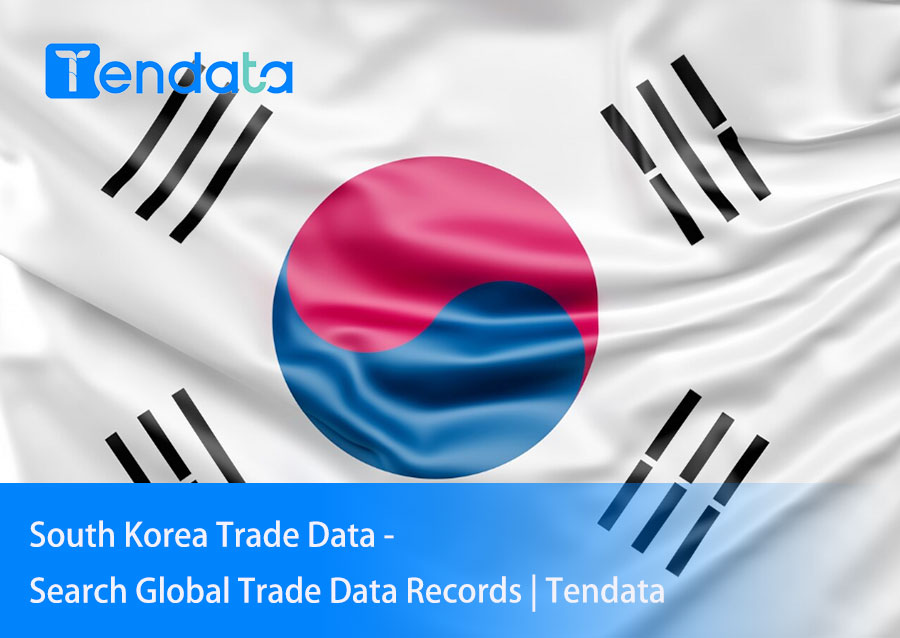 Trade Data
Trade Data
 27-10-2023
27-10-2023
Tendata South Korea Trade Data is available today! As a highly import-dependent country in Asia, South Korea's import/export trade has long been in the spotlight, and Tendata often receives inquiries from customers wanting to learn more about South Korea's import/export data. Now, Importers & Exporters has a quick way to learn more about South Korea's import and export trade.

Let's take a look at South Korea imports and exports in 2023:
South Korea mainly imports fossil fuels, mineral oils, bituminous substances (25 % of total imports), electrical machinery and equipment (18 %), nuclear reactors, boilers, machinery and mechanics (10 %), optical, photographic, cinematographic, surveying (4 %), road vehicles (3 %), iron and steel (3 %), ores, slag, and ash (3 %), organic chemicals (3 %), plastics and their products (2 %), miscellaneous chemicals (2 %), and inorganic chemicals, precious metal compounds (2 %).
China was the largest source of imports (21% of total imports), followed by the United States (12%), Japan (9%), Saudi Arabia, Vietnam, Australia, and Germany (4% each), Taiwan, Russia, and Qatar (3% each), and Kuwait, Malaysia, the United Arab Emirates, and Indonesia (2% each).
South Korea's main exports are electrical and electronic equipment (30% of the total), machinery, nuclear reactors, boilers (12%), railroads, vehicles other than trams (10%), and plastics (7%).
South Korea exports the most products to China (18% of total exports), followed by the United States (17%), the European Union (9%), Vietnam (8.5%), Japan (4.3%), Hong Kong (4.2%), Taiwan (3.6%), Australia (2.9%), India (2.8%) and Singapore (2.7%).

What can you do with Tendata South Korea Trade Data?
1. Data Exploration
-Powerful search engine: You can browse a large amount of data in Tendata South Korea Trade Data anytime, anywhere, and quickly understand the latest market trends.
-Multiple filtering functions: Use product name, product description, customs code, importer's name, exporter's name, country of origin, country of destination, port of origin, port of destination, mode of transportation, weight, quantity, price, etc. to search accurately and realize precise positioning search.
-Understanding the market situation of old customers: through the study of the transaction dynamics of old customers, we can understand the latest needs of old customers, adjust the marketing strategy and expand our market share.
-Discover new customers: Explore potential trading partners and quickly find new customers that fit your needs through the hundreds of thousands of import and export companies provided by Tendata South Korea Trade Data.
2. Data Analysis
-Master the market: Visualize market trends, price trends, and trading trends with data provided by Tendata South Korea Trade Data to get the latest Korea import and export market in real time and gain in-depth industry insights.
-Supply Chain Mapping: Tendata South Korea Trade Data provides you with complete upstream and downstream supply chain information. Through these detailed mappings, you can identify and understand business relationships.
3. Data Management
-Instant Reach: With the T-Rader feature, you can add companies you follow to a list to get the latest updates on that company.
-Data Export: You can download tens of thousands of South Korea Trade Data for detailed analysis for in-depth screening and research.
Category
Leave Message for Demo Request or Questions


 T-info
T-info T-discovery
T-discovery

 My
Tendata
My
Tendata Market Analysis
Market Analysis Customer
Development
Customer
Development Competitor
Monitoring
Competitor
Monitoring Customer Relationship
Customer Relationship





































































































































